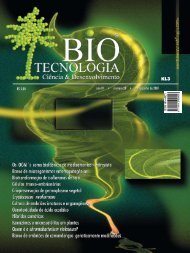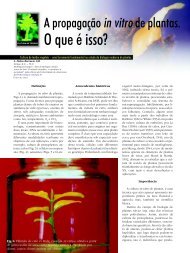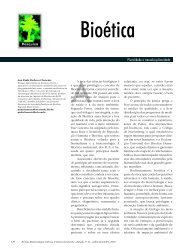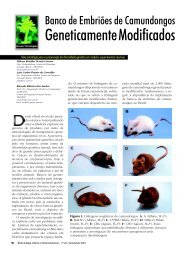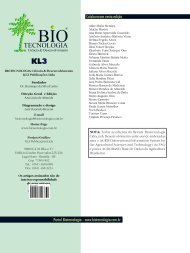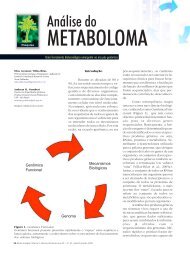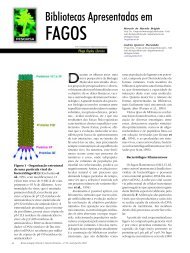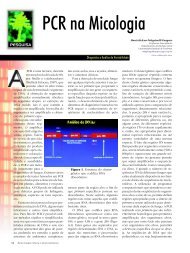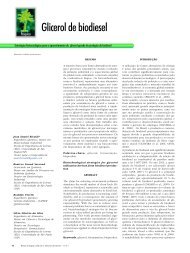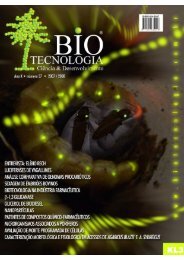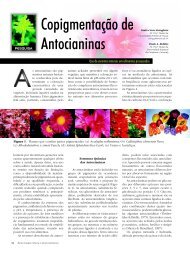Aprendendo com as agrobacterias - Biotecnologia
Aprendendo com as agrobacterias - Biotecnologia
Aprendendo com as agrobacterias - Biotecnologia
You also want an ePaper? Increase the reach of your titles
YUMPU automatically turns print PDFs into web optimized ePapers that Google loves.
menor resistência a antibióticos, menor<br />
impacto ambiental e melhor saúde<br />
animal (Bonneau e Laarveld, 1999).<br />
Considerações finais<br />
Diversos <strong>com</strong>postos, <strong>com</strong>o vitamin<strong>as</strong><br />
e minerais, antioxidantes, ácidos<br />
graxos insaturados, fibr<strong>as</strong> alimentares,<br />
flavonóides, prebióticos e probióticos,<br />
são reconhecidos por prevenir ou retardar<br />
o aparecimento de doenç<strong>as</strong> <strong>com</strong>o<br />
aterosclerose e câncer, dentre outr<strong>as</strong>, e<br />
podem ter seus teores aumentados<br />
nos alimentos pela biotecnologia.<br />
A biotecnologia apresenta grande<br />
potencial para a produção de alimentos<br />
<strong>com</strong> melhores propriedades nutricionais<br />
e funcionais, entretanto o baixo<br />
acesso à literatura científica atualizada<br />
acerca d<strong>as</strong> su<strong>as</strong> possíveis aplicações<br />
tem gerado insegurança e resistência<br />
de certos indivíduos na aceitação dos<br />
seus produtos.<br />
Segundo Roberts et al. (2001), o<br />
conhecimento do genoma e <strong>as</strong> possíveis<br />
modificações na <strong>com</strong>posição nutricional<br />
e funcional dos alimentos podem<br />
ser uma perspectiva futura para a<br />
manipulação de doenç<strong>as</strong> <strong>com</strong>o fenilcetonúria,<br />
enteropati<strong>as</strong> induzid<strong>as</strong> pelo<br />
glúten e intolerância à lactose. Ainda<br />
doenç<strong>as</strong> crônico-degenerativ<strong>as</strong> nãotransmissíveis,<br />
<strong>com</strong>o doenç<strong>as</strong> cardiov<strong>as</strong>culares,<br />
câncer, obesidade, diabetes<br />
mellitus, doença de Parkinson e de<br />
Alzheimer poderão ser melhores conhecid<strong>as</strong>,<br />
diagnosticad<strong>as</strong>, prevenid<strong>as</strong> e<br />
tratad<strong>as</strong>.<br />
O uso do genoma na prevenção<br />
dietética de doenç<strong>as</strong> está por ser estabelecido,<br />
e o campo da nutrição tem<br />
que se tornar mais ativo na demonstração<br />
de mecanismos que direcionem a<br />
conexão entre dieta e fenótipo de<br />
acordo <strong>com</strong> variações genétic<strong>as</strong> específic<strong>as</strong>.<br />
Referênci<strong>as</strong> Bibliográfic<strong>as</strong><br />
Ames, B.N. 2001. DNA damage from<br />
micronutrient deficiencies is likely<br />
to be a major cause of cancer.<br />
Mutation Research. Fundamental<br />
and Molecular Mechanisms of<br />
Mutagenesis, 475: 7-20.<br />
Barbosa, M.C.A. 1997. Determinação<br />
de inibidores de prote<strong>as</strong>es em soja<br />
e em seus derivados protéicos.<br />
Viçosa, MG: UFV, Impr. Univ. 61 p.<br />
Dissertação (Mestrado em Ciência<br />
e Tecnologia de Alimentos) – Universidade<br />
Federal de Viçosa.<br />
Barkovich, R.; Liao, J.C. 2001. Metabolic<br />
engineering of isoprenoids.<br />
Metabolic Engineering, 3: 27-39.<br />
Berg, R.D. 1998. Probiotics, prebiotics<br />
or conbiotics? Trends in<br />
Microbiology, 6: 89-92.<br />
Bonneau, M.; Laarveld, B. 1999.<br />
Biotechnology in animal nutrition,<br />
physiology and health. Livestock<br />
Production Science, 59: 223–241.<br />
Bostid, F.R.R. 1988. Quality-protein<br />
maize. W<strong>as</strong>hington: National<br />
Academic Press. 100 p.<br />
Bouis, H.E. 1999. Economics of<br />
enhanced micronutrient density in<br />
food staples. Field Crops Research,<br />
60: 65-173.<br />
Brinch-Pedersen, H.; Sørensen, L.D.;<br />
Holm, P.B. 2002. Engineering crop<br />
plants: getting a handle on<br />
phosphate. Trends in Plant Science,<br />
7: 118-125.<br />
Chakraborty, S.; Chakraborty, N.; Datta,<br />
A. 2000. Incre<strong>as</strong>ed nutritive<br />
value of transgenic potato by expressing<br />
a nonallergenic seed albumin<br />
gene from Amaranthus<br />
hypochondriacus. PNAS, 97: 3724-<br />
3729.<br />
Chaleff, R.S. 1984. Applications of plant<br />
cell culture to crop improvement,<br />
177-192. In: Puett, D. Human<br />
fertility, health and food. Impact of<br />
molecular biology and<br />
biotechnology. New York: United<br />
Nations Fund for Population<br />
Activities. 254 p.<br />
Chalupa, W.; Galligan, D.T.; Ferguson,<br />
J.D. 1996. Animal nutrition and<br />
management in the 21 st century:<br />
dairy cattle. Animal Feed Science<br />
Technology, 58: 1-18.<br />
Ch<strong>as</strong>sy, B.M. 2002. Food safety<br />
evaluation of crops produced<br />
through biotechnology. Journal of<br />
the American College of Nutrition,<br />
21:166S-173S.<br />
Demain, A.L. 2000. Small bugs, big<br />
business: the economic power of<br />
the microbe. Biotechnology<br />
Advances, 18: 499-514.<br />
Dieryck, W.; Paginier, J.; Poyart, C.;<br />
Marden, M.C. 1997. Human<br />
haemoglobin from transgenic<br />
tobacco. Nature, 386: 29-30.<br />
Dunwell, J.M. 1999. Transgenic crops:<br />
the next generation, or an example<br />
of 2020 vision. Annals of Botany,<br />
84: 269-277.<br />
FAO/WHO. 1998. Human vitamin and<br />
mineral requirements. Report of a<br />
joint FAO/WHO expert<br />
consultation. Food and Agriculture<br />
Organization of the United Nations,<br />
Rome, Italy. 286 p. www.fao.org/<br />
HumanVitaminandMineralRequirements.htm<br />
Forkmann, G.; Martens, S. 2001.<br />
Metabolic engineering and<br />
applications of flavonoids. Current<br />
Opinion in Biotechnology, 12: 155–<br />
160.<br />
Friedrich, M. J. 1999. Genetically<br />
enhanced rice to help fight<br />
malnutrition. JAMA, 282: 1508-<br />
1509.<br />
Garnier, J.P.; Klont, R.; Pl<strong>as</strong>tow, G.<br />
2002. The potential impact of<br />
current animal research on the meat<br />
industry and consumer attitudes<br />
towards meat. Meat Science. Article<br />
In Press, 9p.<br />
Graham, R.; Senadhira, D.; Beebe, S.;<br />
Iglesi<strong>as</strong>, C.; Mon<strong>as</strong>terio, I. 1999.<br />
Breeding for micronutrient density<br />
in edible portions of staple food<br />
crops: conventional approaches.<br />
Field Crops Research, 60: 57-80.<br />
Grotz, N.; Guerinot, M.L. 2002. Limiting<br />
nutrients: an old problem with new<br />
solutions? Current Opinion in Plant<br />
Biology, 5: 158–163.<br />
Grusak, M.A. 2002 Enhancing mineral<br />
content in plant food products.<br />
Journal of the American College of<br />
Nutrition, 21: 178S–183S.<br />
Heyer, A.G.; Lloyd, J.; Kossmann, J.<br />
1999. Production of modified<br />
polymeric carbohydrates. Current<br />
Opinion in Biotechnology, 10: 169–<br />
174.<br />
Hirschberg, J. 1999. Production of highvalue<br />
<strong>com</strong>pounds: carotenoids and<br />
vitamin E. Current Opinion in<br />
Biotechnology, 10: 186–191.<br />
Jensen, L.G.; Olsen, O.; Kops, O.; Wolf,<br />
N.; Thomsen, K.K.; Wettstein, D.<br />
1996. Transgenic barley expressing<br />
a protein-engineered, thermostable<br />
(1,3-1,4)-b-glucan<strong>as</strong>e during<br />
germination. Proc. Natl. Acad. Sci.<br />
USA, 93: 3487-3491.<br />
Kemper, E.L. 1999. Estudo da Modulação<br />
e do Papel Funcional da Enzima<br />
Lisina-Cetoglutarato redut<strong>as</strong>e em<br />
<strong>Biotecnologia</strong> Ciência & Desenvolvimento n.32 - janeiro/junho 2004 53



